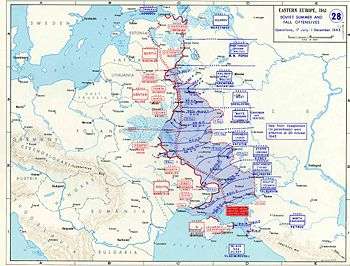Orsha offensives (1943)
| ||||||||||||||||||||||
The Orsha offensives were a series of battles, fought between the Red Army and the Wehrmacht during the winter of 1943. Orsha was a main traffic junction with the north-south road from Leningrad to Kiev and the east-west road from Minsk to Moscow. After the failure of Operation Typhoon in the winter of 1941, Army Group Centre had spent the most part on the defensive in the central sector of the front. The time afforded to them in 1942, a distinct period of inactivity, allowed the Wehrmacht to build formidable defensive positions.
Prelude

After their defeat in the Battle of Smolensk, the Wehrmacht retreated on a broad front to the Panther-Stellung line. The German 4th Army (Heinrici)—part of Army Group Centre—took defensive positions near Orsha. To the north. the 3rd Panzer Army (Reinhardt) took up defensive lines around Vitebsk, and to the south the 9th Army (Model) held the area east of Bobrujsk. The Soviet Stavka saw the liberation of Ukraine as their primary goal, so the Lower Dnieper Offensive had priority in equipment and reinforcements.
The battles
The 4th Army was in retreat to the Panther-Wotan line, pursued by the Soviets. Soviet troops then launched a heavy attack on both sides of the Minsk-Moscow highway. The thrust was directed at Orsha, a main traffic junction.
Notes
References
Literature
Frieser, "Das deutsche Reich und der Zweite Weltkrieg" Vol. 8